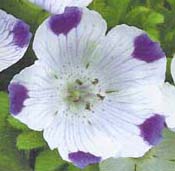






Annual, Nemophila Maculata
The Five Spot flower plant is a low growing annual, that is great as a carpet or bedding plant. Native to the United States, it can be found growing naturally in meadows, by road sides, and along woodlands.
Five Spot gets its name from its flower. The bright white, one inch flowers are, buttercup-shaped. Each of the five white petals have purple veins and a purple spot on the tip of the petal. It is a heavy bloomer from spring thru summer.
Try growing Five Spot in rock gardens, in the front of the flower bed, as a border edging, or in containers on your patio or deck.
Plant Height: 6" - 9"
Did You Know? The latin name for this flower is Nemophila Maculata. "Maculata" means spotted.
Other Names: This plant is also called Buffalo Eyes.
Plant Propagation:
Five Spot flowers are grown from seed. Directly sow seeds into your flower garden in the spring, after the danger of frost has past..You can also start them indoors 6 to 8 weeks before the last frost in your area.
Sow seeds, 1/8" to 1/16" fine, loose soil.
Mark where you plant them, as germination can take up to three weeks.
Days to Germination: 7- 20
Space seeds or seedlings 6" apart.
How to Grow Five Spot Plants:
Five Spot plants grow best in cool weather. Grow plants prefer full to partial sun. In hotter climates, grow them in partial shade.
Five Spot thrives in most soils. If grown in poor soil, mix compost into the soil prior to planting.
Fertilize plants every 6- 8 weeks, with a general purpose fertilizer.
Water plants regularly, especially in hot, dry weather.
Keep plants well weeded in the early growth stage, to allow them to get well established.
Flowers Bloom: Spring thru summer.
Five Spot flowers are tender annuals, They will succumb to the first frost.
Insect and Disease:
Insect and plant disease problems are infrequent.
Copyright © www.100flowers.win Botanic Garden All Rights Reserved